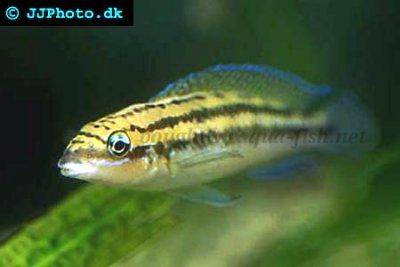Brown julie - Julidochromis dickfeldi
Scientific name: Julidochromis dickfeldi
Common name: Brown julie
Family: Cichlidae
Usual size in fish tanks: 9 - 10 cm (3.54 - 3.94 inch)
014
Recommended pH range: 7.8 - 8.9
Recommended water hardness: 18 - 30°N (321.43 - 535.71ppm)
0°C 32°F30°C 86°F
Recommended temperature range: 24 - 27 °C (75.2 - 80.6°F)
The way how these fish reproduce: Spawning
Where the species comes from: Africa
Temperament to its own species: peaceful
Temperament toward other fish species: peaceful
Usual place in the tank: Middle levels
Food and Feeding
Brown Julies are bottom-oriented feeders and will eagerly consume quality flakes, sinking pellets, and live or frozen bloodworms. Adult fish particularly enjoy treats like cyclopeeze or small crustaceans, which should be offered occasionally to enhance their health and coloration. Feed them in small portions twice a day to avoid overfeeding and maintain water quality.
Origin
Native to Lake Tanganyika in Africa, Julidochromis dickfeldi thrive in the lake's hard, alkaline waters. Their natural habitat consists of rocky shores with numerous crevices and caves, which provide essential hiding and spawning sites. Mimicking these conditions in an aquarium helps them feel secure and promotes natural behaviors.
Sexing
Sexing Brown Julies can be challenging. Females are believed to be slightly larger and rounder than males, although this difference is subtle and not conclusively proven. Observing breeding behavior may be the most reliable method to differentiate sexes.
Breeding
To breed Julidochromis dickfeldi successfully, provide a tank with ample caves and rock formations, as they prefer spawning in secluded areas. The pair will clean and prepare a cave for egg-laying, typically depositing eggs on the underside of rocks or cave ceilings. Once the eggs are laid, both parents diligently guard them, fending off potential predators. After hatching, the fry can be fed newly hatched brine shrimp or Infusoria. Interestingly, juvenile fish often assist in protecting subsequent broods, creating a dynamic, cooperative family structure.
Lifespan
With proper care, Julidochromis dickfeldi can live up to 7 years in captivity, making them a long-term commitment for dedicated aquarists.
Tank Setup and Behavior
Brown Julies are territorial but peaceful cichlids. They establish and defend small territories within the tank, rarely straying far from their chosen areas. A 50-liter (13-gallon) tank is sufficient for a pair, but larger tanks are recommended for groups. Use rocky décor with plenty of caves to replicate their natural habitat and provide hiding spaces. Keep water parameters stable, with a pH of 7.8–8.9, hardness between 18–30°N, and a temperature of 24–27 °C (75.2–80.6 °F).
Compatible Tank Mates
As Lake Tanganyika natives, Julidochromis dickfeldi are best kept with other peaceful cichlids from the same lake. Suitable companions include:
- Neolamprologus brichardi – Known as the Fairy Cichlid, these fish share similar water requirements.
- Cyprichromis leptosoma – Peaceful, schooling cichlids that complement Julidochromis behavior.
- Altolamprologus calvus – A shy cichlid that appreciates similar rocky setups.
- Peacock cichlids – These vibrant cichlids can coexist if tank size and territories are properly managed.
Short Description
Julidochromis dickfeldi, or Brown Julie, is a stunning cichlid ideal for aquarists interested in Lake Tanganyika species. Their manageable size, peaceful temperament, and fascinating breeding behavior make them a rewarding addition to any African cichlid aquarium.
Picture
Bought by aqua-fish.net from jjphoto.dk.


 Thread-finned
Thread-finned  Acara
Acara  Yellow
Yellow  Patrick's
Patrick's  Blue
Blue  Green
Green  Acara
Acara  White
White  Compressed
Compressed  Pastel
Pastel  Midas
Midas  Red
Red  Bluemouth
Bluemouth  False
False  African
African  Agassiz's
Agassiz's  Banded
Banded  Yellow
Yellow  Cockatoo
Cockatoo  Blue
Blue  Blackstripe
Blackstripe  Highfin
Highfin  Redstripe
Redstripe  Threadfinned
Threadfinned  Macmaster’s
Macmaster’s  Panda
Panda  Norbert’s
Norbert’s  Blue
Blue  Thin-line
Thin-line  Three-striped
Three-striped  Viejita
Viejita  Flier
Flier  Archocentrus
Archocentrus  Convict
Convict  Seven
Seven  Spiny
Spiny  Oscar
Oscar  Sunshine
Sunshine  Chitande
Chitande  Firebird
Firebird  Midnight
Midnight  Lake
Lake  Sunshine
Sunshine  Aulonocara
Aulonocara  Nyasa
Nyasa  Ruby
Ruby  Grants
Grants  Aulonocranus
Aulonocranus  Chameleon
Chameleon  Benitochromis
Benitochromis  Orinoco
Orinoco  Yellow
Yellow  Brichard’s
Brichard’s  Guenther’s
Guenther’s  Southern
Southern  Cichla
Cichla  Peacock
Peacock  Chiseltooth
Chiseltooth  Bolivian
Bolivian  Red
Red  Many-pointed
Many-pointed  Jack
Jack  Red
Red  Three
Three  Keyhole
Keyhole  Azureus
Azureus  Red
Red  Jackson’s
Jackson’s  Crenicichla
Crenicichla  Honduran
Honduran  Blue-eye
Blue-eye  Afra
Afra  Frontosa
Frontosa  Slender
Slender  Malawi
Malawi  Chequerboard
Chequerboard  Checkerboard
Checkerboard  Malawi
Malawi  Ectodus
Ectodus  Tanganyika
Tanganyika  Canara
Canara  Green
Green  Rostratus
Rostratus  Pearl
Pearl  Geophagus
Geophagus  Yellowhump
Yellowhump  Suriname
Suriname  Redhump
Redhump  Red
Red  Dority’s
Dority’s  Argentine
Argentine  Burton’s
Burton’s  Victoria
Victoria  Haplochromis
Haplochromis  Jewel
Jewel  Banded
Banded  Lifalili
Lifalili  Lowland
Lowland  Texas
Texas  Pantano
Pantano  Severum
Severum  Banded
Banded  Severum
Severum  Rainbow
Rainbow  Parrot
Parrot  Chocolate
Chocolate  Marlieri
Marlieri  Golden
Golden  Striped
Striped  Masked
Masked  Konye
Konye  Blue
Blue  Trewavas
Trewavas  Electric
Electric  Dwarf
Dwarf  Redbreast
Redbreast  Lamprologus
Lamprologus  Gold
Gold  Greenface
Greenface  Mayan
Mayan  Aurora
Aurora  Blue
Blue  William’s
William’s  Zebra
Zebra  Malawi
Malawi  Blue
Blue  Blue
Blue  Mbuna
Mbuna  Parallel
Parallel  Purple
Purple  Flag
Flag  Bolivian
Bolivian  Ram
Ram  Basket
Basket  Haitian
Haitian  Zebra
Zebra  Striped
Striped  Neolamprologus
Neolamprologus  Brevis
Brevis  Fairy
Fairy  Neolamprologus
Neolamprologus  Cylindricus
Cylindricus  Hecq’s
Hecq’s  Neolamprologus
Neolamprologus  Lemon
Lemon  Mustax
Mustax  Daffodil
Daffodil  Six-bar
Six-bar  Five-bar
Five-bar  Marbled
Marbled  Giraffe
Giraffe  Blue
Blue  Sulphurhead
Sulphurhead  Wolf
Wolf  Jaguar
Jaguar  Blue
Blue  Marakeli
Marakeli  Madagascar
Madagascar  Pinstripe
Pinstripe  Pelmatochromis
Pelmatochromis  Kribensis
Kribensis  Striped
Striped  Red
Red  Deepwater
Deepwater  Fenestratus
Fenestratus  Nichols’
Nichols’  Southern
Southern  Bumble
Bumble  Demason’s
Demason’s  Slender
Slender  Red
Red  Mbuna
Mbuna  Malawi
Malawi  Kenyi
Kenyi  Powder
Powder  Altum
Altum  Angelfish
Angelfish  Angelfish
Angelfish  East
East  Juba
Juba  Earth
Earth  Electric
Electric  Azure
Azure  Lionhead
Lionhead  Discus
Discus  Blue
Blue  Red
Red  Zebra
Zebra  Brichard’s
Brichard’s  Blue
Blue  Firemouth
Firemouth  Zebra
Zebra  Yellow
Yellow  Blue
Blue  Dwarf
Dwarf  Blunthead
Blunthead  The
The  White
White  Twoband
Twoband  Fenestratus
Fenestratus  Window
Window  Tailbar
Tailbar  Black
Black  Redhead
Redhead  Oaxaca
Oaxaca  Xenotilapia
Xenotilapia